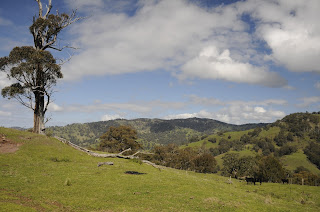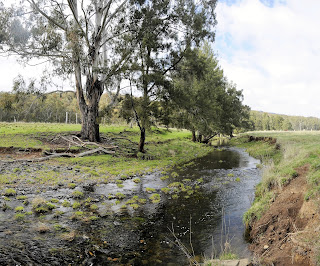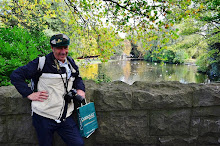FARMER FRED (excerpt from Being There, a book about house sitting)
Crawney Pass is not a name most
Australians are familiar with. Not even
those who live within an hour or so might be familiar with it and yet it has an
almost unique feature that many might find interesting. Apart from a road through interesting scenery
there’s a stand of grass trees (Xanthorrhoeas for the purist) that those who
have travelled the route will, more often than not, mention. “Hundreds of them” is a phrase frequently
used.
So, because I was desperate for a
day out, I picked it as one of two options to put to Col, my friend in
Tamworth, as a suggestion to partially make up for the two day trip to
Coonabarabran that was cancelled by our superiors, so called, as in female
partners.
Col thought that a good idea,
subject to research on Google maps, and two days later arrived early on our
doorstep to set out on our “Boys own” adventure; initially plunging south on
the New England Highway until, just before Wallabadah, we turned off towards
Nundle. The land, in so many locals’ words, “has never been greener” and
“you’ll never see it looking any better than this”. I certainly hadn’t, making it a distinct
pleasure just to be out here, looking at the puddling remnants from the recent
rains and one smaller elongated pond on the far side of some flowering fruit
trees that bade me leap a fence (actually, I strained between some barbed wire
fencing) just to get a shot I envisaged.
It was to be the start of a memorable day’s photography.
I love going out with other male
photographers because they always understand why you want them to stop (even
though they may not visualize what you’re looking at) and have no problem going
down the road and then coming back or even tarrying awhile as you set up your
gear and click off a few frames. This is
in direct contrast to the female genre who seem intent on doing just the
opposite.
So, by the time we arrived at
Nundle we’d already blown about an hour shooting and a steamy brew inside warm
surrounds seemed like an ideal way to spend a half hour. We queried our hostess about the Crawney Pass
road and she knew so little about it I had to fill her in.
We headed south until the bitumen
finished and noted some distinctly odd corrugated iron structures off to our
right. We later learnt that two were
constructed and then the third, more grandiose edifice, had the foundations and
uprights done. That was nine years ago,
nothing much has happened since.
Further along on the opposite
side was a large barn, utilized for functions such as country music. Col had actually attended a couple and
pointed it out, embellishing the view with his information. Then the road started its ascent, winding
midst lonely properties and Crawney Pass National Park until we reached the
apex, or what we assumed was the apex because there was a sign indicating 905
metres and we were now in the Isis River Soil Conservation Area which seemed a
bit incongruous when it stood right beside a 4WD track that had recently
suffered with knobby tyres ripping over it and creating water channels that
facilitated erosion. Indeed, it was
happening even while we were there.
We moved ahead and came to
another rise whereupon another stop was decreed so that we could take in the
view.
This entailed walking through a
gateway, a much more preferable option to climbing over the fence as I’d
already done four times today. We
strolled over to the edge of the rim and took in the panorama. Black cattle espied our presence and moved
away, as they mostly do, increasing their strides the further away they got
until they were almost stampeding down the hill below us. Finally their perceived threat was over and
the thunder of their prancing hooves eased until silence reigned apart from a
couple of currawongs. A peace came over
us as we took it all in, noting the dead logs that had seemingly nothing trying
to break them down. No termite mound, no
fungi, just dead wood from how long ago one could only guess.
We speculated, wrongly as it
turned out, that the peak in the distance would be Mount Crawney, but it
wasn’t. We found that out soon after,
about 30 seconds after we’d returned to the car and were about to leave in fact.
We could hear a vehicle
approaching from somewhere and then farmer Fred and his wife pulled up near
us. We surmised quite quickly that they
probably had something to do with the property and we surmised right. Fred came over and we had to explain why we’d
pulled up (“admiring the view” without telling him we’d trespassed) and he
seemed content with that but added that others had been on the acreage without
permission and he hoped people would ask first.
Of course we would, if only you can find the owners!
Fred told us they’d had half a
metre of rain since June 1st which was heading into record
territory. The bits of the Isis we’d
seen reflected that because it’s usually a trickle at best in the upper reaches
but today it had the distinct appearance that it might be something you could
call a river.
colnewman@netspace.net.au
We parted company and the road
wound downhill for a kilometre or two until we spied another pleasant creek
setting to photograph. Out beyond it, on
slightly higher ground, was Fred’s house or, more specifically, Fred’s
brother’s house because he just looked after the property for his brother who
was, as they say in Australia, a “Pitt Street Farmer”, residing in Sydney.
As we yet again broached the
boundaries and settled into some stream side photography, Fred and his wife
drove by but thankfully didn’t hassle us as we’d assumed he’d given us unspoken
authority when he said he wasn’t worried about our type of person.
He’d tipped us off that the Xanthorrhoeas
weren’t that much further but soon after we stopped to shoot a standout
weathered gum tree and decided to take lunch.
We’d been munching, drinking and reminiscing for 10 minutes when I just
happened to glance across to the other side of the road and there, in the near
distance, was a significant stand of our sought after trees. Taking in the direction of the road we
figured a few hundred metres down the way would bring us to a better spot to
view them and so it transpired. The next
batch were only about three minutes’ walk and there were hundreds of them.
We ventured this way and that in
our excitement until, about 20 minutes later, my camera battery ran out just
when I’d reached the furthest point I’d intended to go. That necessitated a long haul back to the
ute, calling out for Col all the way because I guessed I might need the keys.
He never replied so I found
myself trying the doors to no avail and then having to climb the hill for the
third time until I eventually found him and he complained that I always rush
off and leave him, which was probably right.
He also said he’d heard me but his replies hadn’t carried to me.
Anyhow, I got the keys and
changed cameras because the spare battery for the one I’d been using had been
lost at my Bangalow Creek excursion a couple of weeks earlier. Funny how things come back to haunt you.
Hiking up the hill for the fourth
time I started to feel fatigue, the muscles starting to get reluctant to
stretch out once more but the need for more pictures driving me upwards. Occasionally I came across wounded examples
of the species and I could but reflect on my experiences at Esperance when I
went on a hike and came across several crumbling versions of the grass tree,
all devastated by phytophthora, a relative of the fungal disease that caused
the potato blight in Ireland. According
to one authority over there, it’s causing more damage than climate change and
mining combined, so now, every time I see a damaged one, I wonder if it’s
suffering the same fate.
After an hour we hit the road
again and it was only about a kilometre down the road when the bitumen
returned. Suddenly we were on a good
road surface and the reason became immediately apparent because the bitumen
ends exactly where there’s a limestone quarry.
Still, it was good for us also as
we followed the Isis to Blandford, a nondescript village where I recently got
booked by the speed camera, and then turned back towards Tamworth, stopping at
Murrurundi as advised by Col, at a special place called Nelliebellie’s. Now, I thought I had good knowledge of the
Murrurundi scene but this was on the opposite side of the road to where I used
to pull up. It was seemingly run by two
affable ladies whose bouncy disposition made you want to stop and soak some of
that up anyway.
They also have a small library of
books for sale for a pittance, yet another attraction for Col and I, except
that, as a professional book reviewer, I get a lot for nothing these days. Still, it’s wonderful to see that book
reading is still promoted.
We adjourn to the outside tables
and chairs on the back lawn; very rustic and very relaxing, before a large
serving of some cake was served up with a dollop of ice cream and cream. That and the chai latte left us full and
wondering what we were going to tell Col’s wife, Sue, who was at home preparing
the evening fest, when we found we were too full to stomach any more. Just have to wing it through without fessing
up, as I usually do.











0 Comments:
Post a Comment
<< Home